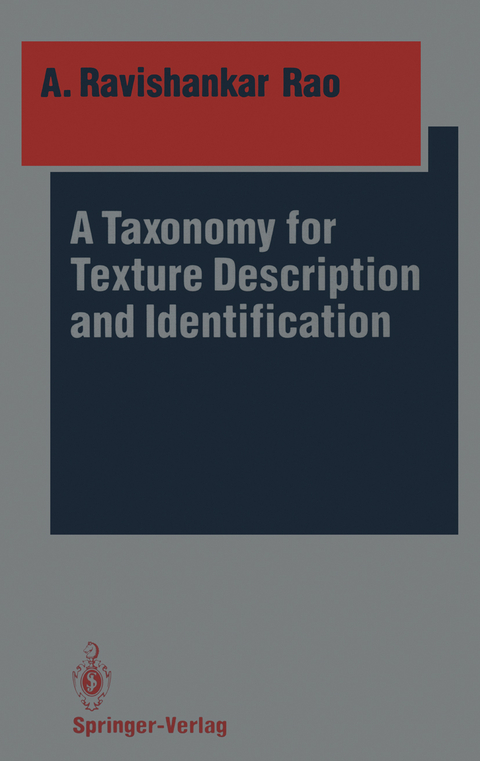
A Taxonomy for Texture Description and Identification
Springer-Verlag New York Inc.
978-1-4613-9779-3 (ISBN)
A central issue in computer vision is the problem of signal to symbol transformation. In the case of texture, which is an important visual cue, this problem has hitherto received very little attention. This book presents a solution to the signal to symbol transformation problem for texture. The symbolic de- scription scheme consists of a novel taxonomy for textures, and is based on appropriate mathematical models for different kinds of texture. The taxonomy classifies textures into the broad classes of disordered, strongly ordered, weakly ordered and compositional. Disordered textures are described by statistical mea- sures, strongly ordered textures by the placement of primitives, and weakly ordered textures by an orientation field. Compositional textures are created from these three classes of texture by using certain rules of composition. The unifying theme of this book is to provide standardized symbolic descriptions that serve as a descriptive vocabulary for textures. The algorithms developed in the book have been applied to a wide variety of textured images arising in semiconductor wafer inspection, flow visualization and lumber processing. The taxonomy for texture can serve as a scheme for the identification and description of surface flaws and defects occurring in a wide range of practical applications.
1 Introduction.- 1.1 Scope of the book.- 1.2 Importance of texture.- 1.3 Potential applications of this research.- 1.4 Issues in automated process control involving computer vision.- 1.5 A taxonomy for texture.- 1.6 Outline.- 2 Computing oriented texture fields.- 2.1 Introduction.- 2.2 Background.- 2.3 Oriented Texture Fields.- 2.4 Experimental Methods.- 2.5 Experimental Results.- 2.6 Analyzing texture at different scales.- 2.7 Processing of the intrinsic images.- 2.8 Conclusions.- 3 The analysis of oriented textures through phase portraits.- 3.1 Introduction.- 3.2 Background.- 3.3 Geometric theory of differential equations.- 3.4 Experimental Methods.- 3.5 Experimental Results.- 3.6 Experiments with noise addition.- 3.7 A related model from fluid flow analysis.- 3.8 Discussion.- 3.9 Conclusion.- 4 Analyzing strongly ordered textures.- 4.1 Introduction.- 4.2 Extraction of primitives.- 4.3 Extracting structure from primitives.- 4.4 Models for strongly ordered textures.- 4.5 Symbolic descriptions: models from petrography.- 4.6 Frieze groups and wallpaper groups.- 4.7 Implications for computer vision.- 4.8 Summary.- 5 Disordered textures.- 5.1 Statistical measures for disordered textures.- 5.2 Describing disordered textures by means of the fractal dimension.- 5.3 Computing the fractal dimension.- 5.4 Experimental Results.- 5.5 Conclusion.- 6 Compositional textures.- 6.1 Introduction.- 6.2 Primitive textures.- 6.3 A Parametrized symbol set.- 6.4 Three types of composition.- 6.5 Linear combination (transparent overlap).- 6.6 Functional composition.- 6.7 Opaque overlap.- 6.8 Definition of texture.- 6.9 A complete taxonomy for texture.- 6.10 Implementing the taxonomy.- 6.11 Conclusion.- 7 Conclusion.- 7.1 Summary of results.- 7.2 Contributions.- 7.3 Future Work.- B Region Refinement.- C Preparation of the manuscript.- Permissions.
| Erscheint lt. Verlag | 1.7.2012 |
|---|---|
| Reihe/Serie | Springer Series in Perception Engineering |
| Zusatzinfo | XXIII, 198 p. |
| Verlagsort | New York, NY |
| Sprache | englisch |
| Maße | 155 x 235 mm |
| Themenwelt | Informatik ► Grafik / Design ► Digitale Bildverarbeitung |
| Mathematik / Informatik ► Informatik ► Software Entwicklung | |
| Informatik ► Theorie / Studium ► Künstliche Intelligenz / Robotik | |
| Informatik ► Weitere Themen ► Hardware | |
| ISBN-10 | 1-4613-9779-0 / 1461397790 |
| ISBN-13 | 978-1-4613-9779-3 / 9781461397793 |
| Zustand | Neuware |
| Informationen gemäß Produktsicherheitsverordnung (GPSR) | |
| Haben Sie eine Frage zum Produkt? |
aus dem Bereich


